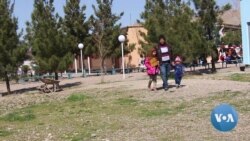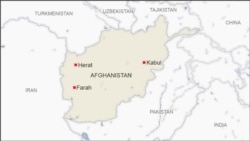WASHINGTON / HERAT, AFGHANISTAN — Iran’s worsening coronavirus outbreak is driving some of the country’s millions of Afghan migrants and refugees to return to Afghanistan at dramatically increased rates, according to a U.N. migration body.
In a Tuesday report, the International Organization for Migration said the number of Afghans returning to Afghanistan from Iran via the two official border crossings of neighboring countries doubled in the first week of March compared with the previous week.
The agency said 19,562 undocumented Afghans passed through the Islam Qala and Milak border crossings into the Afghan provinces of Herat and Nimroz from March 1 to March 7. The figure was up 106% from the previous week’s tally of 9,478 Afghans who made the crossings.
The IOM report attributed the data to the Afghan government’s Border Monitoring Team of the Directorate of Refugees and Repatriation.
The U.N. High Commissioner for Refugees estimates that Iran is home to more than 3 million Afghans, of whom around 900,000 are refugees and the rest are migrants, including passport holders and undocumented Afghans.
The IOM report said spontaneous returns of Afghans from Iran have “increased dramatically due to the closures of work sites in Iran and the annual spring harvest in Afghanistan.”
“The vast majority of Afghans in Iran are there for economic reasons, and most of them work in the Iranian construction industry or seasonal agriculture,” said Kabul-based IOM emergency response officer Nicholas Bishop in a phone interview with VOA Persian. “The widespread prevalence of the virus in Iran is part of the reason why its labor camps for Afghans are closing.”
The coronavirus has further weakened an Iranian economy that has been in recession since 2018 under the strain of toughening U.S. sanctions and government mismanagement.
Bishop said the Afghan migrants are concentrated primarily in the Iranian cities of Tehran, Mashhad and Qom. He said more than 80% of them do not have official Iranian work permits.
Medical services
Several Afghans who left Iran via the Islam Qala crossing this week told VOA’s Afghan Service that a lack of access to Iranian medical services amid the virus outbreak also drove them to return to Afghanistan.
“We returned of our own free will because we were scared of this virus,” said a woman named Shah Bibi. “There was not any help or services for Afghans over there.”
Abdul Razaq Jamshidi, another returnee, said he wanted the Afghan government to test him and other returnees for the virus to see if they had been infected.
“In Iran, Afghans do not dare go to health facilities because they [Iranian authorities] do not care about Afghans … they do not even care about their own people,” he said.
The UNHCR has credited Iran in recent years for introducing policies “conducive to … the attainment of rights for the Afghan population.” It has said those policies include “enhancing access to education, health, and livelihood services to refugees with minimal financial aid from the international community.”
The accounts of the Afghan returnees who spoke to VOA indicated that Iran’s health care system remains inaccessible to some Afghans despite the enhancements cited by the UNHCR.
Open borders
The passage of thousands of Afghans from Iran to Afghanistan in recent days also has highlighted the Afghan government’s decision to keep official border crossings open, despite several of Iran’s other neighbors shutting their own border crossings.
Iran, which reported its first coronavirus cases and deaths February 19, has suffered one of the world’s worst outbreaks.
Afghan authorities initially shut the border crossings with Iran February 23 but re-opened them two days later.
Afghan National Security Council spokesman Javid Faisal tweeted that two-way traffic through the border crossings would resume based on World Health Organization guidelines and Afghan government health control measures.
The IOM’s Bishop said WHO has cautioned governments against closing border crossings as a way to contain a disease outbreak.
“The Iran-Afghanistan border is incredibly porous and there are a lot of informal crossings,” he said. “When you close official border crossings, it doesn’t mean the flow of people will stop, it means they will go through informal crossings where there are no health screening teams. It’s better for migrants to go through international crossings where you have Afghan health personnel doing symptom screenings with support from IOM.”
Some provincial officials in Herat told VOA’s Afghan Service, though, that keeping the border crossings open has its own risks.
“People who come back from the infected areas [in Iran] could carry the virus,” said Asef Kabir, a public health official in Herat.
Seven confirmed cases
Afghanistan had seven confirmed coronavirus cases as of Wednesday, after confirming its first case on February 24.
“Before [the outbreak], we normally would have about 300 to 500 returnees from Iran per day,” said Jawed Nadem, head of Herat’s refugee repatriation department. “Last week, we started with 1,200 returnees per day and then it went up to 2,200 per day. Yesterday, we had an overwhelming number of returnees — more than 4,800. It is very concerning.”
Herat Governor Abdul Qayum Rahimi told reporters Wednesday that local authorities were planning to bar people from crossing into Iran starting Thursday. “We cannot restrict those returning from Iran, as Kabul should decide on that matter,” he added.
Bishop credited Rahimi with imposing restrictions on public activity in Herat to prevent the spread of the virus.
“I’m sure local governments in the region will take measures to protect their populations,” he said.
This article originated in VOA’s Persian Service, in collaboration with VOA’s Afghan Service.










